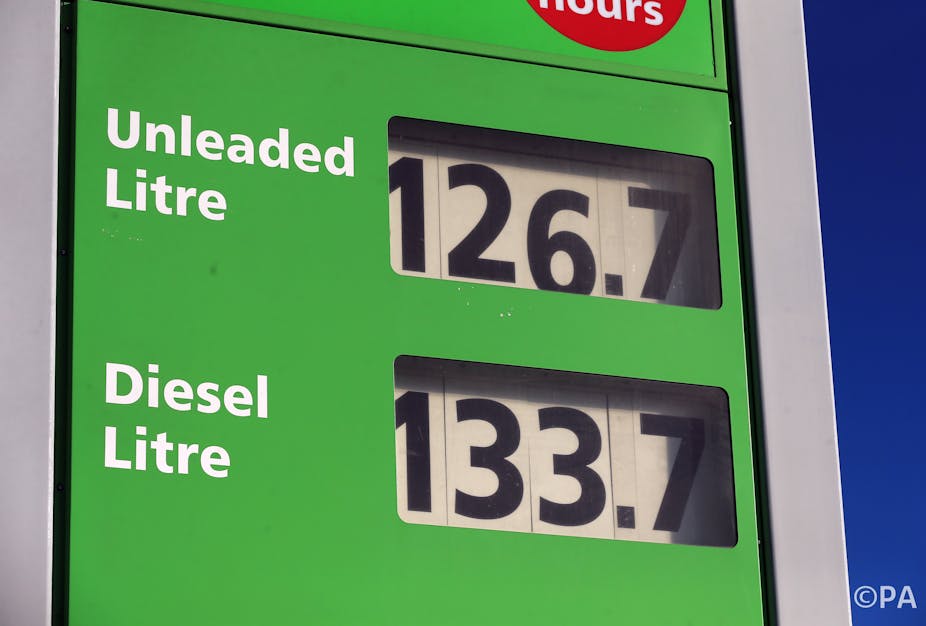Which is the better option for cars in cities, diesel or petrol-driven engines? As a report reveals the new fleet of green, hybrid electric-diesel buses in London produce less CO2 but more harmful pollutants than their diesel equivalents, what do we mean by “better”?
The two main factors that differentiate diesel and petrol as fuels are their environmental impact, and their fuel economy.
Diesel vehicles have long been associated with better fuel economy than petrol vehicles, and many countries have provided incentives to help drive sales of diesel cars in preference to their petrol equivalents. In 2012, sales of diesel vehicles in the UK amounted to more than half of new car sales.
One of the principal reasons for this is that European vehicle manufacturers have made a large investment in producing diesel vehicles and market them strongly. One feature they are sold on is better fuel consumption, which stems largely from EU legislation on fuel economy for new cars.
Less CO2 is not the whole picture
Prompted by climate change concerns and the need to reduce CO2, these limit new vehicles’ emissions to 130g CO2 per kilometre. The European Commission proposed in July 2012 to reduce this to 95g CO2/kilometre by 2020. These emissions are based on the vehicles’ fuel consumption as measured in regulatory tests under relatively benign laboratory driving conditions.
There are two problems with this. Fuel consumption under real world driving conditions (as opposed to lab tests) is significantly higher than the “official” data quoted in adverts. A recent International Council for Clean Transportation (ICCT) study showed that in European and US cars, the average discrepancy between lab test and real fuel consumption rose from 10% in 2001 to 25% in 2011. This is clear evidence that the regulatory lab test cycle simply doesn’t capture the effects of more aggressive driving in real road conditions, or the effects of the stop-start driving in cities. It also shows that driving more economically could deliver large fuel savings – enough to offset any fuel economy advantage that diesel gives.
The second problem is that diesel cars emit significantly higher levels of air pollutants than petrol cars fitted with three-way catalytic converters, which convert carbon monoxide, unburnt fuel hydrocarbons and nitrogen oxides (NOx) to harmless water, carbon dioxide and nitrogen. The discrepancy between the level of emissions such as (NOx) from diesel and petrol vehicles can be seen in lab tests; in the real world it’s even greater.
The fact is that while catalytic converters have reduced petrol engine emissions to extremely low levels, diesel engine emissions of NOx have shown no appreciable reduction over the past 20 years.
This demonstrates a remarkable failure of EU regulation: despite the lack of improvement in real world emissions, emissions recorded during the regulatory lab tests have declined in line with the increased stringency of European regulations. This emphasises just how “soft” the lab test cycle is, and that it fails to provide a genuine indication of how air pollutants are emitted in the real world.
Power versus pollutants
While the rated maximum power of petrol engines has remained almost constant over the past 20-25 years, the power of diesel engines has dramatically increased, by around 50%. Engines of greater power burn up more nitrogen from the air, producing more harmful nitrogen oxides and a greater impact on health and the environment.
Not only have diesel vehicles failed to clean up their act as expected, but the EU’s own approved tests and regulations have failed to pick up on the fact that diesel vehicles have for years largely failed to comply the limits on emissions such as nitrogen dioxide emissions. Last year, diesel exhaust was classified by the International Agency for Research on Cancer as a Class 1 human carcinogen.
Cleaning up after
So what is to be done? The latest rounds of European emissions reductions require particulate filters to be fitted to diesel vehicles which will reduce harmful emissions of particulate matter. They also require reductions in NOx emissions. However, both of these emissions are still likely to be higher than from petrol cars as filters can degrade or fail, and NOx is still likely to be higher than from petrol even from the newest diesels. There are even companies who offer to remove particle filters from diesel cars to allegedly improve vehicle performance, although a recent announcement from the Department for Transport has stated a missing filter would constitute an MOT failure.
What does appear to be the case is that even the latest diesel vehicles will emit more NOx and particulates than petrol vehicles, meaning that diesel cars – in the real world – are more polluting overall than their petrol equivalents. Despite decades of industry investment in diesel vehicles, with the right choice of petrol engine and, crucially, with the appropriate economical use of the right foot while driving, any perceived CO2 shortcomings of petrol vehicles can be overcome.

